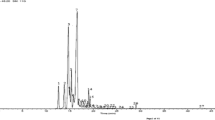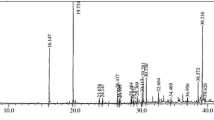Abstract
The essential oil from the leaves of Blumea mollis was extracted and the chemical constituents and the larvicidal against Culex quinquefasciatus effects studied. The analyses of gas chromatography (GC) and GC–mass spectroscopy (GC–MS) revealed that the leaf essential oil of B. mollis contained 39 compounds, and the major chemical compounds identified were linalool (19.43%), γ-elemene (12.19%), copaene (10.93%), estragole (10.81%), Allo-ocimene (10.03%), γ-terpinene (8.28%) and Allo-aromadendrene (7.44%). The essential oil had significant toxic effect against early fourth-instar larvae of C. quinquefasciatus with LC50 = 71.71 and LC90 = 143.41 ppm. The results could be useful in search of newer, safer and more effective natural larvicidal agent against C. quinquefasciatus.
Similar content being viewed by others
References
Adebayo TA, Gbolade AA, Olaifa JI (1999) Comparative study of toxicity of essential oils to larvae of three mosquito species. Niger J Nat Prod Med 3:74–76
Cheng SS, Liu JY, Tsai KH, Chen WJ, Chang ST (2004) Chemical composition and mosquito larvicidal activity of essential oils from leaves of different Cinnamomum osmophloeum provenances. J Agric Food Chem 52:4395–4400
Dharmagadda VSS, Naik SN, Mittal PK, Vasudevan P (2005) Larvicidal activity of Tagetus patula essential oil against three mosquito species. Bioresource Technol 96:1235–40
El Hag EA, Nadi AH, Zaitoon AA (1999) Toxic and growth retarding effects of three plant extracts Culex pipiens larvae(Diptera: Culicidae). Phytother Res 13:388–392
El Hag EA, Rahman Abd-El, El-Nadi H, Zaitoon AA (2001) Effects of methanolic extracts of neem seeds on egg hatchability and larval development of Culex pipiens mosquitoes. Indian Vet J 78:199–201
Gbolade AA, Oyedele AO, Sosan MB, Adewayin FB, Soyela OL (2000) Mosquito repellent activities of essential oils from two Nigerian Ocimum species. J Trop Med Plants 1:146–148
Guga Bakshi DN, Sensarma P, Pal DC (1999) A lexicon of medicinal plants in India, vol 1. Naya Prokash, Culcutta, p 290
Knio KM, Usta J, Dagher S, Zournajian H, Kreydiyyeh S (2008) Larvicidal activity of essential oils extracted from commonly used herbs in Lebanon against the seaside mosquito, Ochlerotatus caspius. Bioresour Technol 99:763–768
Prabakar K, Jebanesan A (2004) Larvicidal efficacy of some Cucurbitacious plant leaf extracts against Culex quinquefasciatus (Say). Bioresource Technol 95:113–114
Prajapati V, Tripathi AK, Aggarwal KK, Khanuja SPS (2005) Insecticidal, repellent and oviposition-deterrent activity of selected essential oils against Anopheles stephensi, Aedes aegypti and Culex quinquefasciatus. Bioresour Technol 96:1749–1757
Rajasekariah GR, Parab PB, Chandrashekar R, Deshpande L, Subrahmanyan D (1991) Pattern of Wuchereria bancrofti microfilaraemia in young and adolescent school children in Bessein, India, an endemic area for lymphatic filariasis. Ann Trop Med Parasitol 85(6):663–665
Singh NP, Kumari V, Chauhan D (2003) Mosquito larvicidal properties of the leaf extract of a herbaceous plant, Ocimum canum (Family: Labitae). J Commun Dis 35(1):43–45
Sukumar K, Perich MJ, Booba LR (1991) Botanical derivatives in mosquito control: a review. J Am Mosq Control Assoc 7:210–237
Thomas TG, Rao S, Lal S (2004) Mosquito larvicidal properties of essential oil of an indigenous plant, Ipomoea cairica Linn. Jpn J Infect Dis 57:176–177
Tiwary M, Naik SN, Tewaryb DK, Mittalc PK, Yadavc S (2007) Chemical composition and larvicidal activities of the essential oil of Zanthoxylum armatum DC (Rutaceae) against three mosquito vectors. J Vector Borne Dis 44:198–204
Traboulsi AF, El-Haj S, Tueni M, Taoubi K, Nader NB, Mrad A (2005) Repellency and toxicity of aromatic plant extracts against the mosquito Culex pipiens molestus (Diptera: Culicidae). Pest Manag Sci 61:597–560
World Health Organisation (1981) Instruction for determining the susceptibility or resistance of mosquito larvae to insecticides. WHO-VBC 81.807, pp 1–6
Acknowledgements
The authors are grateful to Dr. R. Panneerselvam, Professor and Head, Department of Botany, Annamalai University for providing laboratory facilities for the study.
Author information
Authors and Affiliations
Corresponding author
Rights and permissions
About this article
Cite this article
Senthilkumar, A., Kannathasan, K. & Venkatesalu, V. Chemical constituents and larvicidal property of the essential oil of Blumea mollis (D. Don) Merr. against Culex quinquefasciatus . Parasitol Res 103, 959–962 (2008). https://doi.org/10.1007/s00436-008-1085-2
Received:
Accepted:
Published:
Issue Date:
DOI: https://doi.org/10.1007/s00436-008-1085-2




